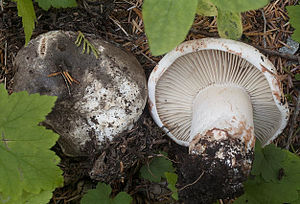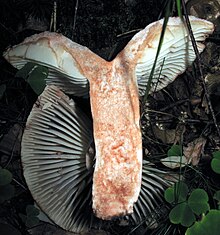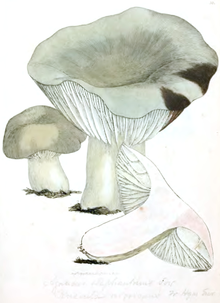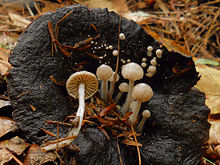Thick-leaved black blotch
| Thick-leaved black blotch | ||||||||||||
|---|---|---|---|---|---|---|---|---|---|---|---|---|

Thick-leaved black-deaf bling ( Russula nigricans ) |
||||||||||||
| Systematics | ||||||||||||
|
||||||||||||
| Scientific name | ||||||||||||
| Russula nigricans | ||||||||||||
| Fr. |
The conditionally edible thick-leaved black deafness ( Russula nigricans ) is a fungus from the family of deaf relatives . It is a large, compact, earth-colored deafblin that has the farthest and thickest lamellae and the hardest flesh of all the deafblings. The meat, which is usually mild in taste, first reddened when cut and then blackened. The fruiting bodies of the very common mycorrhizal fungus appear from June to October on almost all soils in both deciduous and coniferous forests, most frequently under beech and spruce.
features
The thick-leaved black-blotch is a large, stately mushroom. His hat is between (5) 7-17 (25) cm wide. Young it is pale whitish and convex, but soon flattens out and turns greyish to sooty brown. Later it is almost black and depressed in the middle. The hat skin often bursts with age and is about 2/3 removable.
The slats are very far apart. You can have a distance of 5 mm and more at the edge. They are also unusually thick and rigid. In the young mushroom, the lamellae are yellowish white, with age they turn brownish black. Under pressure, they split immediately and turn brick-red until they turn grayish-black after a while. The slats are up to 15 mm high and strongly mixed with intermediate slats. They are embroidered or rounded on the stem.
The stem is mostly short (3–8 cm long) and very thick (1.5–3 cm wide), smooth, firm and discolored like the hat. It is usually cylindrical in shape or thickened towards the base.
The flesh is unusually firm and whitish. If you break or cut off a piece of the hat or stem, the fungus will turn reddish in color within a few minutes. The fungus later turns grayish, then blackish, within hours. The mushroom usually tastes mild, sometimes also slightly hot. The smell is unobtrusive. Young mushrooms often smell a little fruity, while older ones have a dull odor. The spore powder is white.
Microscopic features
The round to ellipsoidal spores are 6.4–8.5 µm long and 5.4–6.6 µm wide. The Q value (quotient of spore length and width) is 1.1–1.3. The spore ornament is up to 0.4 µm high and consists of numerous, partly elongated warts, which are mostly connected in a net-like manner by fine, rarely burr-like connections. The apiculus measures 1.25–1.37 × 1.12–1.25 µm, the hilar spot is inamyloid .
The club-like, mostly 4-spore basidia measure 40–55 × 8–10 µm. The cylindrical to clubbed, 50–65 µm long and 3.5–7 µm wide cheilocystidia contain a noticeably refractive content that turns gray-brown in sulfobenzaldehyde. The numerous, similarly shaped pleurocystides measure 30–55 × 3.5–7 µm.
The top layer of the hat consists of hair-like, 3–7 µm wide hyphal end cells, which are more or less cylindrical and can sometimes be slightly pointed towards the top. The hyphae , which are septated one to several times, can sometimes be swollen up to 12 µm thick. They contain a vacuolar, brown pigment. Pileocystides do not occur.
Species delimitation
Due to its thick, very distant lamellae and the first reddening and then blackening flesh, the thick-leaved black deafness should not be confused with any other deafness. Most likely it could be confused with the rare black tarnish deafbling ( Russula albonigra ), the meat of which first turns black-violet and then completely black and has a menthol-like taste.
ecology
Connection with trees
As a mycorrhizal fungus , the thick-leaved black-deaf fungus enters into a symbiosis with very different tree species. So come spruce , fir , birch , Book , hornbeams and oaks as the host in question. The fungus can therefore be found in both deciduous and coniferous forests between June and October. He also makes no demands on the floor. Although it prefers acidic soils such as sand, loam / clay and silicate soils, it can also cope with limestone soils. Usually it appears sociable.
Connection with other mushrooms
The thick-leaved black-blotch is not only mycorrhizal partner of trees, it also takes on an important ecological function as a host for some parasitic fungi. Its solid fruit bodies are so stable that they hardly rot, but rather dry up and slowly disintegrate. They become completely black and look charred. It is not uncommon to find small colonies of white, parasitic fungi on these supernatant fruiting bodies. Usually it is mostly the dusting hermaphrodite ( Asterophora lycoperdoides ) or the veiled hermaphrodite ( Asterophora parasitica ).
distribution
The thick-leaved black-blotch is widespread and common throughout Europe. It is also found in Central and North America (Canada, USA, Mexico, Costa Rica,) North Africa (Morocco) and North Asia (Japan, Korea).
In Germany, the thick-leaved black blot is widespread and one of the most common blots.
Systematics
The Latin species attribute ( epithet ) " nigricāns " means blackish or blackening .
Inquirerous classification
The thick-leaved black-blotch belongs to the sub-genus Compactae and here in the subsection Nigricantinae , in which the black- blotch whose flesh turns red, gray or black when injured. It is closely related to the dense-leaved black-deaf ( Russula densifolia ), the black- tarnished deaf ( Russula albonigra ) and the smoky-brown black-deaf ( Russula adusta ).
use
The thick-leaved black-deaf mushroom is a decidedly inferior edible mushroom because of its hard and not very aromatic meat, which should only be eaten when it is very young.
swell
literature
- Hans E. Laux (ed.): The Cosmos PilzAtlas . Franckh-Kosmos Verlag, Stuttgart 2002, ISBN 3-440-10622-5 , p. 184 .
- H. Romagnesi: Russula nigricans. In: Les Russules d'Europe et d'Afrique du Nord (1967). MycoBank, the Fungal website, accessed May 8, 2011 (French).
- Russula nigricans. CBS Fungual Biodiversity Center, accessed May 8, 2011 .
Individual evidence
- ↑ a b Marcel Bon (ed.): Parey's book of mushrooms . Franckh-Kosmos Verlag, Stuttgart 2005, ISBN 3-440-09970-9 , p. 54 .
- ↑ a b Westfälische Mushroom Letters: Mushrooms all-round description of the thick-leaved black deaf (PDF; 6.4 MB, p. 178).
- ↑ a b Species description of Russula nigricans in Singer "Monograph of the genus Russula"; published in "Beihefte zum Botanischen Centralblatt", editor A. Pascher (1932) p. 368. (PDF; 354 kB) and p. 369. (PDF; 343 kB).
- ↑ Josef Breitenbach, Fred Kränzlin (Ed.): Pilze der Schweiz. Contribution to knowledge of the fungal flora in Switzerland. Volume 6: Russulaceae. Milklings, deafblings. Mykologia, Luzern 2005, ISBN 3-85604-060-9 , p. 208.
- ↑ a b Russula nigricans in the PilzOek database. In: pilzoek.de. Retrieved August 21, 2011 .
- ^ Basidiomycota Checklist-Online - Russula nigricans. In: basidiochecklist.info. Retrieved September 27, 2012 .
- ↑ Belgian Species List 2012 - Russula nigricans. In: species.be. Retrieved June 7, 2012 .
- ↑ Cvetomir M. Denchev, Boris Assyov: Checklist of the larger basidiomycetes in Bulgaria . In: Mycotaxon . tape 111 , 2010, ISSN 0093-4666 , p. 279–282 ( online [PDF; 592 kB ; accessed on August 31, 2011]).
- ↑ Z. Tkalcec, A. Mesic: Preliminary checklist of Agaricales from Croatia V: . Families Crepidotaceae, Russulaceae and Strophariaceae. In: Mycotaxon . tape 88 , 2003, ISSN 0093-4666 , p. 293 ( cybertruffle.org.uk [accessed August 31, 2011]).
- ^ Estonian eBiodiversity Species description Russula nigricans. In: elurikkus.ut.ee. Retrieved June 13, 2012 .
- ↑ Worldwide distribution of Russula nigricans. (No longer available online.) In: data.gbif.org. Archived from the original on December 22, 2015 ; Retrieved August 21, 2011 . Info: The archive link was inserted automatically and has not yet been checked. Please check the original and archive link according to the instructions and then remove this notice.
- ↑ Elias Polemis et al: Mycodiversity studies in selected ecosystems of Greece: 5. (PDF; 330 kB) Basidiomycetes associated with woods dominated by Castanea sativa (Nafpactia Mts., Central Greece). In: Mycotaxon 115 / mycotaxon.com. 2008, p. 16 ff , accessed on August 22, 2011 .
- ↑ Gordana Kasom, Mitko Karadelev: Survey of the family Russulaceae (Agaricomycetes, Fungi) in Montenegro . In: Warsaw Versita (ed.): Acta Botanica Croatica . tape 71 , no. (2) , 2012, ISSN 0365-0588 , p. 1–14 ( online [PDF]). online ( Memento of the original from April 27, 2016 in the Internet Archive ) Info: The archive link was inserted automatically and has not yet been checked. Please check the original and archive link according to the instructions and then remove this notice.
- ^ Russula nigricans / Norwegian Mycology Database. In: nhm2.uio.no / Norwegian Mycology Database. Retrieved September 27, 2012 (English).
- ↑ NMV Verspreidingsatlas | Russula nigricans. In: verspreidingsatlas.nl. Retrieved May 7, 2012 .
- ^ TV Andrianova and others: Russula nigricans. Fungi of Ukraine. In: www.cybertruffle.org.uk/ukrafung/eng. 2006, accessed on May 3, 2012 .
- ↑ nigricans: German → Latin: PONS.eu language portal. Retrieved June 6, 2012 .
Web links
- Synonyms of Russula nigricans. Index Fungorum, accessed May 8, 2011 .
- Russula nigricans. In: Funghi in Italia / funghiitaliani.it. Retrieved June 1, 2014 (in Italian, photos of the thick-leaved black-and-white).
- Russula nigricans. In: Russulales News . Bart Buyck, accessed June 1, 2014 (English, original Latin diagnosis).
- Karin Montag: The thick-leaved blackish-deaf in the virtual mushroom book. In: Tintling.com . Retrieved June 1, 2014 .




